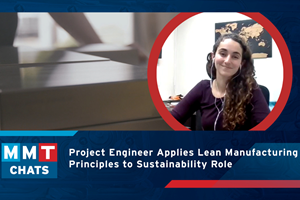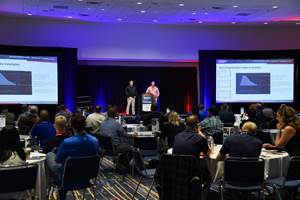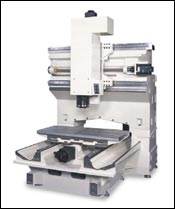The Cost of Machine Tool Ownership
How older technology will impede your business in a competitive global market and how to invest properly in moldmaking equipment.
Purchasing the right tools for manufacturing dies and molds can save considerable time and money down the line, regardless of the upfront cost. There are many factors that affect the real cost of ownership—ranging from financing and resale value, uptime and operation efficiency to consumable tooling costs and reduced secondary operations to improved accuracy. Here we will explain how older technology will impede your business in a competitive global market and how to invest properly in moldmaking equipment.
Implementing the Right Strategy
To be successful, you first have to eliminate as much labor and as many operations as possible. By having the correct tools, whether cutting tools, the machine itself and/or the software, these items are necessary for the speed and accuracy required in today’s market. If you can do all of this and run unattended, then your cost will go down and the better quality and accuracy will go up as a result. The bottom line is making a better product for the customer.
Simply put, the older the technology, the more manual labor is used which costs more money in the long run. Whether the labor is in operating the machine, secondary operations such as polishing or hand work, the best way to reduce costs and get the piece delivered more quickly is to cut as much manual labor as possible.
The older technology refers to CNC machines usually eight or more years old with slower rpms and that have no software on the machine to control acceleration and deceleration. This doesn’t mean that there aren’t new machines still made using this outdated technology. Making large heavy cuts at slow feedrates was the norm at one time. However, the slower spindles with the higher horsepower cause poor tool life and poor surface finish. Old-style toolholders include ER collets systems and the endmill holders with set screws. The runout and balance on these holders is not suitable for tool life or surface finish.
That is when it’s time to replace that outdated CNC with a new or high-end machining center with features that create labor cost savings through the use of toolchangers, tool lasers and proper cutting techniques, which means more volume with the same staff.
In a typical production-type environment, cost justification for a per-part piece is fairly black and white: A shop needs to produce X many parts, so they purchase X equipment. However, in a moldmaking environment, it’s much more difficult because the end product goes through many different areas throughout the shop.
If you look just at the machining portion, faster is not necessary cost efficient. It’s not just the hours on the machine; it’s all the secondary hours or operations such as EDM or polishing that need review. The true cost of ownership is the total cost to produce your mold insert and that includes how much money is saved reducing secondary operations.
Breaking Down the Cost
For example, if you currently machined a core or cavity insert on your traditional CNC machine in 50 hours at $65 an hour ($3,250) and added approximately $300 for consumable tooling costs, two days of polishing (16 hrs X $50/hr) at $800 and one day of spotting at $400 (8 hrs x $50/hr) your total cost for production would total $4750. Investing in newer technology would reduce your production costs by 25 percent by decreasing machine hours to (30 x 100 = $3000), consumable tooling costs to $200 and spending fewer hours polishing (5 hrs x $50 = $250) and spotting (2 hr x $50/hr = $100).
With the new technology the total cost would be reduced to $3450.
The consumable tooling lasts longer when used in the higher quality machines. The simple fact that you spend less time changing tools is a savings not to mention the ability to cut an entire part with one tool for 20 or 30 hours with no blends from tool wear.
If EDM is required, it may be possible to machine these details using newer equipment for even further savings. When companies try to cut ribs and small features with older technology, it is not cost efficient due to the existing machine quality. The new high-speed machines are capable of cutting very small details that were previously produced using EDM.
With current technology, the finish and accuracy that will allow that mold to be closed, and spotted together (sealed off to make the part) will happen much quicker. Years ago, a mold was put into a spotting press and one to two days were spent hand-grinding and fitting the mold together. Now when these parts are cut to the necessary accuracies, it’s down to hours instead of days. That is significant. Knocking two days off your delivery time saves you time and money.
Running a machine unattended, overnight may not provide a cost savings if the older technology is only running one tool to complete the job. Some shops claim that they are doing lights-out with their older machines; however, it is just because their programs took so long to run. They leave the machines running, but at a reduced feedrate to be safe, etc. The shops believe they are getting something for free—even though it is a very low productivity level compared to the true, unattended, lights-out facilities that are talked about today.
Examining Finance Costs
When it comes to looking at finance costs, purchasing a higher quality machine will lower the monthly payment because the finance company will usually offer a higher residual compared with the less quality machines based on the true resale value.
Examples
Fair Market Value
As of 12-1-07
$100,000.00
Commodity VMC at 60 months @ $1,596.05, in advance
Residual of 23%
Fair Market Value
12-1-07
$200,000.00
High End VMC2
60 months @ $3,015.78, in advance
Residual of 29%
Fair Market Value
12-1-07
$200,000.00
Commodity VMC at 60 months @ $3,192.09, in advance
Residual of 23%
Time to Buy
Depending on the status of the equipment, it is recommended to purchase at least one new piece of equipment if you are currently using outdated technology and replace current technology every two to three years.
If you have a quality piece of equipment that is only two to three years old, it holds its value very well. When it’s time to upgrade, it’s very easy to trade up—much like leasing your car. The people who don’t invest in newer technology just cannot compete and they may slowly die off. Those who do invest seem to stay busy, and thus competitive.
Summary
Essentially, if you want to stay with the new machine technology because it is giving you all of these added features, and if you keep flipping these machines over every three years, you’ll find that the cost will go down over time, because you are just paying the difference between the two. Trying to replace five machines at a time is a very large investment to make at one time which is not cost-effective for most small mold shops.
References
1 Okuma MB-46VAE.
2Okuma.
3 MB-56-VA.
Related Content
Certified Quality Management for Plastics Professionals – Materials to Tooling to Recycling
Why is certification of a shop’s quality management system to ISO 9001, AS9100, IATF 16949 or ISO 13485 so special? What does the certification signify? And what supports the paper behind the framed certificate?
Read MoreExploring ISO 9000 - Part 16 Control of Quality Records
A Series of International Standards for Quality Management and Quality Assurance. We begin 2022 with a review of Clause 4.16 Control of Quality Records.
Read MoreMMT Chats: Project Engineer Applies Lean Manufacturing Principles to Growing Sustainability Role
MoldMaking Technology Editorial Director Christina Fuges catches up with MMT’s 30-Under-30 Honoree Katherine Pistorius, who has added Regional Sustainability Coordinator alongside her Project Engineer duties, which demonstrates the many paths one can take in a manufacturing career. Here she shares how this opportunity unfolded for her and what the job entails today and in the future. This episode is brought to you by ISCAR with New Ideas for Machining Intelligently.
Read MoreMoldMaking Conference Session Spotlight: Data
Want to learn about digital workflows in mold design or ERP or global mold monitoring and asset management or the impact of tooling digitalization?
Read MoreRead Next
Getting to Know Your Machine Tool
A review of the six core components of a machine tool: automatic toolchanger, motor/drive/encoder, base casting, OSP control, turret and spindle.
Read MoreHow to Select and Use Your Vertical Machining Center
Competitive shops need to consider the true capabilities of their VMCs to achieve a high level of accuracy and surface finish.
Read MoreReasons to Use Fiber Lasers for Mold Cleaning
Fiber lasers offer a simplicity, speed, control and portability, minimizing mold cleaning risks.
Read More









.png;maxWidth=300;quality=90)






.jpg;maxWidth=300;quality=90)



_300x250 1.png;maxWidth=300;quality=90)









